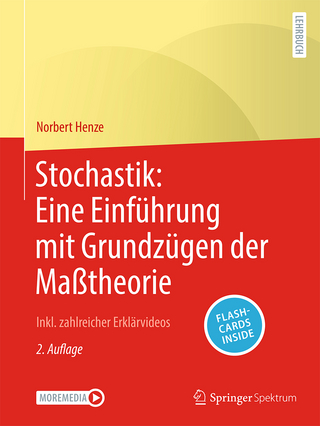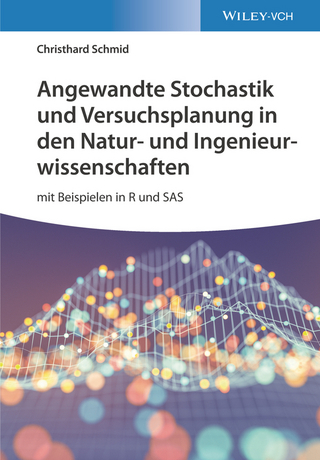
Statistical Design and Analysis for Intercropping Experiments
Springer-Verlag New York Inc.
978-0-387-97923-6 (ISBN)
- Titel ist leider vergriffen;
keine Neuauflage - Artikel merken
Intercropping is a method of sustaining or improving soil structure by growing two or more crops on the same field. It is a technique of wide application and of growing importance for both commercial and subsistence farmers. This textbook provides a comprehensive survey of the design and analysis of intercropping experiments. Its main themes are that techniques such as relative indices make it possible to cover a wide variety of conditions, and that statistical models for density-yield relations enable recommendations to be made to growers of crops. As a result, graduate students and researchers in statistics, biometry, and agriculture whose study involves intercropping will find this an invaluable text and reference.
1 Introduction and Definitions.- 1.1. Introduction and Objectives.- 1.2. Statistical Design.- 1.3. Types of Treatment.- 1.4. Treatment Designs in Category 4 for Intercropping Experiments.- 1.5. Some Statistical Problems Associated with Response Model Equations, Statistical Analyses, and Inferences.- 1.6. Some Concepts and Definitions.- 1.7. Literature Cited.- 2 One Main Crop Grown with a Supplementary Crop.- 2.1. Objectives and Introduction.- 2.2. Some Examples of Main Crops Grown with a Supplemental Crop.- 2.3. Statistical Designs and Univariate Analyses of Main Crop Yields for Experiments on Main and Supplemental Crops.- 2.4. Some Additional Statistical Analyses for Yields of Main Crop Intercropped with a Supplemental Crop.- 2.5. Multivariate Analyses for a Main Crop Grown with Supplemental Crops and Grown as a Sole Crop.- 2.6. Summary and Discussion.- 2.7. Problems.- 2.8. Literature Cited.- 3 Both Crops Main Crops-Density Constant-Analyses for Each Crop Separately.- 3.1. Objectives and Introduction.- 3.2. Treatment and Experiment Designs.- 3.3. Univariate Analyses on Observed Variables for Each of the Two Main Crops.- 3.4. Multivariate Analyses on a Vector of Observed Variables of One Crop.- 3.5. Summary and Discussion.- 3.6. Problems.- 3.7. Literature Cited.- 4 Both Crops Main Crops-Density Constant-Combined Crop Responses.- 4.1. Objectives and Introduction.- 4.2. Univariate Analyses on Functions of Combined Variables of Both Crops.- 4.3. Land Equivalent Ratio or Relative Yield Total.- 4.4. Multivariate Analysis on an Observation Vector of the Intercropping Systems.- 4.5. Effect of Varying Proportions on Created Functions.- 4.6. Summary and Discussion.- 4.7. Problems.- 4.8. Literature Cited.- Appendix 4.1.- 5 Both Crops of Major Interest with Varying Densities.- 5.1. Objectives and Introduction.- 5.2. Treatment Design and Statistical Analysis for Comparisons Among Density Combinations for Individual Crop Responses.- 5.3. Statistical Analyses for Responses from Both Crops for a Single Pair of Crops at Varying Densities.- 5.4. Models and Analyses for Monocultures and Mixtures of Two Crops over a Range of Densities.- 5.5. Analyses for c1 Lines of Crop 1 and c2 Lines of Crop 2.- 5.6. Summary and Discussion.- 5.7. Problems.- 5.8. Literature Cited.- Appendix 5.1. Derivation of Parameter Estimates and Their Variances Using a Generalized Least Squares Method for the Linear Model of Section 5.4 (Prepared by Anila Wijesinha).- Appendix 5.2. Distribution of Estimators and Hypothesis Tests (Prepared by Anila Wijesinha).- 6 Monocultures and Their Pairwise Combinations when Responses Are Available for Each Member of the Combination.- 6.1. Introduction.- 6.2. Treatment Design.- 6.3. A Response Model and Some Statistical Analyses.- 6.4. Summary and Discussion.- 6.5. Problems.- 6.6. Literature Cited.- Appendix 6.1.- Appendix 6.2.- 7 Monocultures and Their Pairwise Combinations when Separate Crop Responses Are Not Available.- 7.1. Introduction.- 7.2. Treatment Designs.- 7.3. Response Model Equations and Some Statistical Analyses.- 7.4. Response Models for a Crop Competition Experiment.- 7.5. Summary and Discussion.- 7.6. Problems.- 7.7. Literature Cited.- Appendix 7.1. Derivation of Solutions for Response Model for Design 3.- Appendix 7.2. Derivation of Solutions and Variances for Model 4, Example 7.5.- 8 Spatial and Density Arrangements.- 8.1. Introduction.- 8.2. Spatial Arrangements-Density Constant.- 8.3. Spatial Arrangements-Density Variable.- 8.4. Statistical Analyses for the Arrangements in Section 8.3.- 8.5. Summary and Discussion.- 8.6. Problems.- 8.7. Literature Cited.- 9 Some Analytical Variations for Intercropping Studies.- 9.1. Introduction.- 9.2. Replacement Series.- 9.3. Other Indices.- 9.4. Linear Programming.- 9.5. Summary and Discussion.- 9.6. Problems.- 9.7. Literature Cited.- 10 Experiment Designs for Intercropping Experiments.- 10.1. Introduction.- 10.2. Principles of Design of Experiments.- 10.3. Zero-Way Elimination of Heterogeneity.- 10.4. One-Way Elimination of Heterogeneity.- 10.5. Two-Way Elimination of Heterogeneity.- 10.6. Split Plot and Split Block Designs.- 10.7. More Complex Experiment Designs.- 10.8. Plot Technique.- 10.9. Stability Concepts and Parsimonious Experiment Design.- 10.10. Problems.- 10.11. Literature Cited.
| Reihe/Serie | Springer Series in Statistics |
|---|---|
| Zusatzinfo | biography |
| Verlagsort | New York, NY |
| Sprache | englisch |
| Gewicht | 620 g |
| Einbandart | gebunden |
| Themenwelt | Mathematik / Informatik ► Mathematik ► Wahrscheinlichkeit / Kombinatorik |
| Weitere Fachgebiete ► Land- / Forstwirtschaft / Fischerei | |
| ISBN-10 | 0-387-97923-9 / 0387979239 |
| ISBN-13 | 978-0-387-97923-6 / 9780387979236 |
| Zustand | Neuware |
| Informationen gemäß Produktsicherheitsverordnung (GPSR) | |
| Haben Sie eine Frage zum Produkt? |
aus dem Bereich


